
MELANIN
The pigment that causes different skin colours

Molecule of the Month - March 2016

Paul May
University of Bristol, UK

|

“And I told about equality, And it's true
Either you're wrong or you're right
But if you're thinkin' about my baby
It don't matter if you're black or white.”
|
That’s a Michael Jackson song isn’t it?
Yes, it’s all about how skin colour shouldn’t be an issue when it comes to human relationships.
But what causes skin colour?
A group of polymeric molecules collectively known as melanin. There are actually three main types of melanin produced by special cells called melanocytes and stored in organelles called melanosomes. The most common melanin found in humans, eumelanin, is composed of cross-linked dihydroxyindole polymers, and there are two types of these, brown eumelanin and black eumelanin, depending upon the exact nature of the polymer bonds. It is made by oxidation of the amino-acid tyrosine, followed by polymerisation.

Tyrosine

Indole-5,6-quinone
The dihydro version replaces
the 2 C=O's with C-OH's.
|
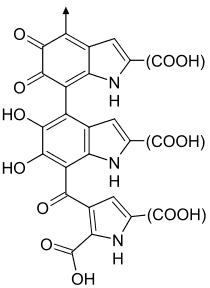
Part of the structural formula of eumelanin.
The groups labelled "(COOH)" can be COOH or H.
The polymer continues at the arrow.
|
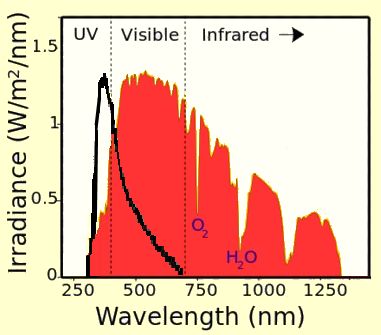
The intensity of sunlight reaching the Earth's surface
as a function of wavelength (red) overlaid with the absorption spectrum of eumelanin (black).
The eumelanin absorbs most of the harmful UV radiation below about 350 nm
as well as a large part of the visible making it appear black.
|
What does it do?
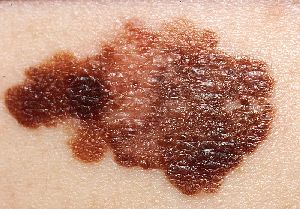 Melanin is a dark pigment which is extremely efficient at absorbing UV light from the sun, preventing the harmful UV from damaging cells leading to skin cancer (melanoma, as shown in the photo, right). The more melanin you have in your skin, the better protected you are against sunlight exposure, and also the darker your skin tone. Eumelanin also colours hair, which would normally be transparent; the presence of black eumelanin causes hair to be black, whereas brown eumelanin causes hair to be brown or blonde depending on its concentration. As we age, the melanocytes in the hair follicles stop working efficiently and the melanin levels decrease, leading to paler (grey) hair.
Melanin is a dark pigment which is extremely efficient at absorbing UV light from the sun, preventing the harmful UV from damaging cells leading to skin cancer (melanoma, as shown in the photo, right). The more melanin you have in your skin, the better protected you are against sunlight exposure, and also the darker your skin tone. Eumelanin also colours hair, which would normally be transparent; the presence of black eumelanin causes hair to be black, whereas brown eumelanin causes hair to be brown or blonde depending on its concentration. As we age, the melanocytes in the hair follicles stop working efficiently and the melanin levels decrease, leading to paler (grey) hair.
Eumelanin is also found in the iris protecting the eyes from UV damage. At low pigment concentrations eyes appear pale grey, blue or green as a result of a combination of the pigment colour and Rayleigh scattering of light in the front of the iris (the same scattering effect which causes the sky to appear blue). But with higher melanin concentrations eyes appear dark brown or black. In rare cases, the pigment can vary in concentration between eyes of the same individual. David Bowie (photo, below) is a famous case of someone who had heterochromia iridis, a genetic disorder causing one eye to have a different colour to the other due to variations in melanin.
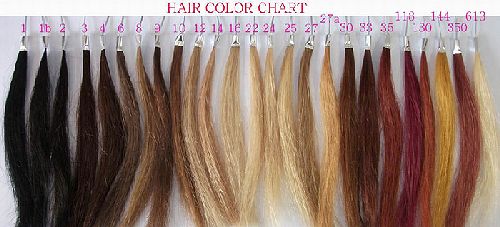
Range of human hair colours due to different
concentrations and combinations of melanin. |
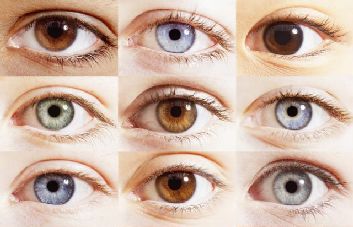
Range of human eyes colours.
The colours are caused partly by the melanin content and partly by light scattering. |
What about the other melanins?
The second one is called pheomelanin, and is a pigment similar to eumelanin, found in the skin and hair. The difference is that this pigment is red, and is found in areas of the body like the lips and nipples. In the hair, when pheomelanin is mixed with small amounts of brown eumelanin, the result is red or ‘ginger’ hair. Eumelanin is less chemically stable than pheomelanin and breaks down faster after death. It is for this reason that many Egyptian mummies have reddish hair!

The late David Bowie
An example of someone with heterochromia iridis.
|
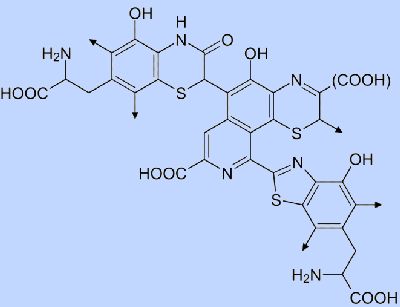 |
Part of the structural formula of pheomelanin.
The groups labelled "(COOH)" can be COOH or H.
The polymer continues at the arrows. |
And the third melanin?
This one is called neuromelanin, and is somewhat different from the other two in that it is not used as a pigment, but is instead thought to be a protective molecule in the brain. Its structure allows it to bind potentially toxic transition-metal ions, such as iron, preventing them from causing damage to the nerve cells. These ions have been implicated in various neurological diseases, such as Parkinson’s, so neuromelanin is thought to mop up the toxic ions, preventing these diseases. As before, with aging, less neuromelanin is produced, and we become less protected against these diseases, which is possibly why Parkinson’s disease affects mainly elderly people.
If the main purpose of melanin in the skin is to protect us from UV, why aren’t all humans black?
It is believed that the range of human skin colours is directly related to the amount of sunlight into which different humans have adapted in different regions of the world. Although too much UV can cause skin cancer, too little UV is also a problem in that humans require UV light to synthesis vitamin D in the skin, without which bones do not develop properly, leading to conditions such as rickets (see the MOTM article about vitamin D). So to remain healthy, humans need to get the balance right between too much and too little UV exposure.

The range of human skin colours.
[Image: Sarah Leen, National Geographic]
Humans originally evolved in Africa and were exposed to intense sunlight, and so all early humanoids had black skin containing high concentrations of eumelanin to protect them against the damaging UV. Even today, people that live near the tropics have black or dark skin tones. However, with the melting of the ice sheets at the end of the last ice age, 60,000-125,000 years ago, early humans migrated out of Africa into more temperate regions, with less sunlight. These early humans now had too much melanin in their skins for the low sunlight conditions at these higher latitudes, and so could not synthesise enough vitamin D to remain healthy. But over many generations they adapted to this new environment by reducing the melanin content in their skin, hair, and eyes. The less sunlight there is, in general, the paler the skin, hair and iris colour. For example, Scandinavians tend to be very pale skinned with blonde or red hair, and pale blue/grey eyes.
But nowadays people move all over the world...
Yes, that’s true – and modern transport allows them to migrate faster than their bodies can adapt. So pale-skinned humans adapted to low-sunlight conditions that move to live in sunny climates (e.g. British and European ex-pats that now live in Australia) often have a high incidence of skin cancer. And Africans and Indians that migrate to cloudy European countries often have a higher than normal incidence of rickets. Both of these problems can be counteracted, of course, by using suncreams or vitamin D supplements, respectively.
What about suntanning?
That is the body’s attempt to protect itself from increased sunlight, by locally increasing melanin production and hence its concentration in the exposed skin areas. But different skin types tan in different ways. Very pale skin often burns before it tans, whereas light-brown skin will darken or tan easily and rarely burn, while black skin will remain unchanged and never burn.
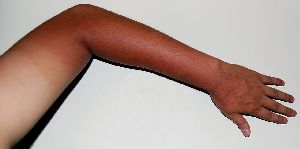
A suntanned arm
[Image by Onetwo1 at the English language Wikipedia. Licensed under CC BY-SA 3.0 via Commons}
Are there people with no melanin at all?
Yes, people and animals. These are called albinos, and usually result from a genetic disorder that leads to an absence of tyrosinase, an enzyme involved in the production of melanin. Albinos are characterised by an absence of pigment in the skin, hair and eyes (or in animals, fur, feathers and scales as well). Indeed, their irises are so transparent that their eyes often appear pink as a result of seeing the red blood vessels in the retina at the back of the eyeball. Although albinos are generally as healthy as normal people, the lack of melanin in their skin makes them very susceptible to skin cancers and sunburn, and they often suffer from poor eyesight or sensitivity to bright lights. Hollywood, as usual, has often used these physical differences to portray albinos as cold assassins, with probably the most famous example being that of Silas, the albino hitman in the movie The Da Vinci Code. In reality, of course, the poor eyesight suffered by albinos would make them very unlikely to be the crack-shot needed to be a hit-man! The sad fact is that in many parts of the world, particularly in Africa, human albinos are perceived as being unnatural, and these people are persecuted or even killed out of fear of the unknown.
|

Silas the killer albino (played by Paul Bettany) from the movie The Da Vinci Code.
|

An albino penguin
|
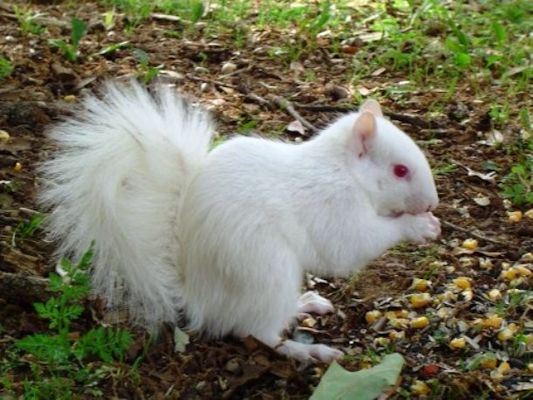
An albino squirrel
|
If animal colours come from melanin too, why aren't all animals just brown or black?
True - animals and birds often have fur or plumage that come in a startling range of vivid colours, not just the browns and blacks you might expect from melanin alone. Just like humans, animals and birds can synthesise melanin, and this results in the standard browns and blacks of most fur and feathers. But crucially, animals cannot synthesise many other, more colourful pigments. However, plants and bacteria can. Plants produce a range of pigments, such as carotenoids and xanthophylls, which can have a range of colours from reds, greens and yellows. When animals eat these plants, the pigments can be transported to the hair follicles or feathers, producing vivid colours in the fur or plumage. So the colour of some birds and animals can change depending upon what they eat!
One example is the Red Cardinal bird which mainly eats berries containing red/orange carotenoids. These molecues end up in the bird's feathers. Different pigments (yellow, red, and orange) can also be absorbed from other seeds, so the combination and amount of all these seeds/berries eaten by the bird at different times of the year determine the colour of its vibrant plumage. Indeed, if you kept a colourful wild bird like a Cardinal in captivity and fed it only one type of seed, its feathers would gradually become duller with each molt.

A Red Cardinal
gets its red colour from the berries it eats.
|
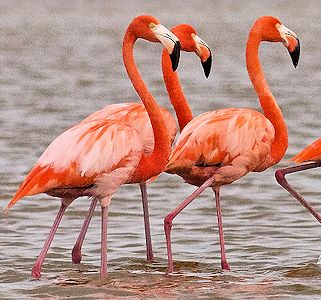
'Pink' Flamingos
get their pink colour from the shrimp they eat.
|
Flamingos are another example. They are only pink because they eat pink plankton-like animals such as shrimp. But the shrimp themselves are only pink because they consume microscopic algae which synthesise red and yellow pigments. So these pigments colour the shrimp, which then colour the feathers in flamingos. Flamingos kept in zoos often do not have access to the right type of shrimp, so would be an insipid grey colour. This wouldn't be very appealling to the zoo visitors, who paid to see brightly coloured flamingos! So most zoos supplement the diet of their flamingos with plant pigment extracts, to artificially make them pink. Salmon get their pink colour in a similar way, and farmed salmon would normally look an unappetising grey. Salmon farmers add plant pigments to the salmon food to make the fish look pink.
And it is now believed dinosaurs were highly coloured, too.
How so?
Examination of fossils has shown they contain microscopic structures which resemble melansomes. A recent study on the fossilised feathers of a bird-like dinosaur called Anchornis huxleyi using TOF SIMS and IR reflectance spectroscopy has analysed the surviving pigments found in these supposed melanosomes. The pigments were found to be virtually identical to animal eumelanin. This proved the structures are melanosomes (and not just fossilised bacteria), and also allowed the colour of the feathers to be determined. They are believed to be black and white on its body and wings, but with a bright red/orange head-crest. So maybe soon we'll know the true colours of all the other dinosaurs as well, and the next Jurassic Park movie will be very colourful indeed!
|

Suggested colours of Anchornis huxleyi
|
Bibliography
- Michael Jackson official website
- Wikipedia: Melanin,
Neuromelanin, Human skin colours, Eye colours, Hair colours, Albinism, Heterochromia iridis
- National Geographic article on origins of skin colour
- Smithsonian Human Skin Color Variation, The Smithsonian National Museum of Natural History (Skin colours and related melanomas)
- Celebrities with Heterochromia
- P. Meredith, J. Riesz, Photochem. and Photobiol. 79 (2004) 211 (Sunlight absorbance of melanin).
- M. Brenner, V.J. Hearing, Photochem. and Photobiol. 84 (2008) 539. (Protective role of melaninin the skin)
- V.J. Hearing and K. Tsakamoto, The FASEB J. 5 (1991) 2902. (Pheomelanin production and location)
- G. Greco, L. Panzella, L. Verotta, M. d'Ischia, A. Napolitano. J. Natural Prod. 74 (2011) 675. (Structure of pheomelanin)
- H. Fedorow, F. Tribl, G. Halliday, M. Gerlach, P. Riederer, K.L. Double. Prog. Neurobiol. 75 (2005) 109. (Function of neuromelanin)
- B.J. Nicolaus. Med. Hypotheses 65 (2005) 791. (Review of function of neuromelanin)
- K. Jimbow, W.C. Quevedo, Jr, T.B. Fitzpatrick, G. Szabo. J. of Invest. Dermatol. 67 (1976) 7. (melanin as a mammallian pigment)
- Risks and Benefits of Sun Exposure. Cancer Council Australia. May 3, 2007.
- N. Agar N and A.R. Young AR, Mutation Res. 571 (2005) 121. (Melanin production in the skin and cancer)
- J.A. Parrish, K.F. Jaenicke and R.R. Anderson, Photochem. and Photobiol. 36 (1982) 187. (Melanin production in the skin).
- The Da Vinci Code (movie)
- Albinos in Hollywood movies
- Tanzania albinos targeted again. BBC News. 2008-07-27. (Persecution of albinos in Africa)
- Plant colours
- Animal colourations
- Discussion about the colour of dinosaurs


 Back to Molecule of the Month page. [DOI:10.6084/m9.figshare.5259886]
Back to Molecule of the Month page. [DOI:10.6084/m9.figshare.5259886]
![]()
![]()
![]()
![]()





 Melanin is a dark pigment which is extremely efficient at absorbing UV light from the sun, preventing the harmful UV from damaging cells leading to skin cancer (melanoma, as shown in the photo, right). The more melanin you have in your skin, the better protected you are against sunlight exposure, and also the darker your skin tone. Eumelanin also colours hair, which would normally be transparent; the presence of black eumelanin causes hair to be black, whereas brown eumelanin causes hair to be brown or blonde depending on its concentration. As we age, the melanocytes in the hair follicles stop working efficiently and the melanin levels decrease, leading to paler (grey) hair.
Melanin is a dark pigment which is extremely efficient at absorbing UV light from the sun, preventing the harmful UV from damaging cells leading to skin cancer (melanoma, as shown in the photo, right). The more melanin you have in your skin, the better protected you are against sunlight exposure, and also the darker your skin tone. Eumelanin also colours hair, which would normally be transparent; the presence of black eumelanin causes hair to be black, whereas brown eumelanin causes hair to be brown or blonde depending on its concentration. As we age, the melanocytes in the hair follicles stop working efficiently and the melanin levels decrease, leading to paler (grey) hair.










